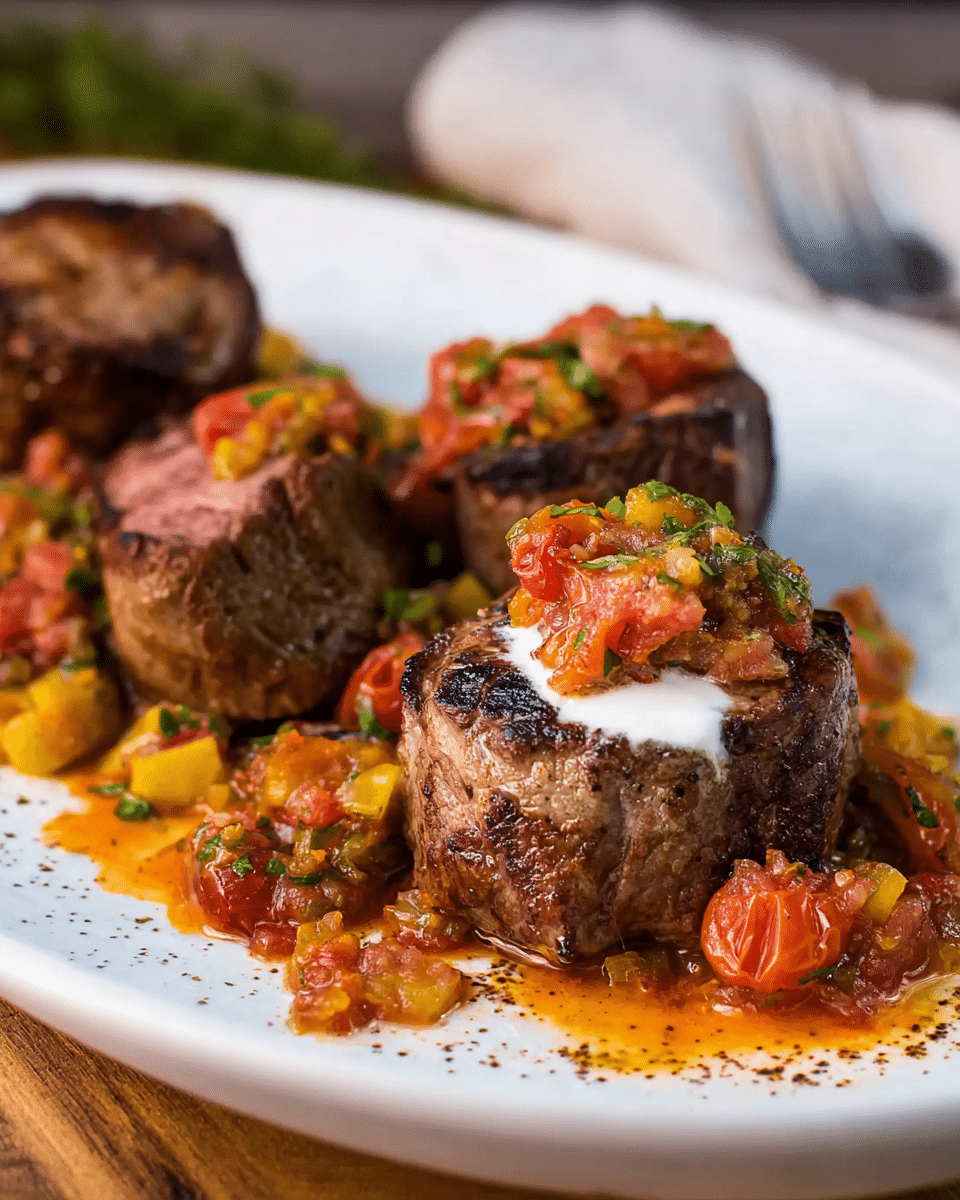Pan Roasted Beef Tenderloin Medallions with Tomato Relish is a restaurant-quality dish you can easily make at home. Juicy filet medallions are seared in butter and garlic, oven-finished to perfection, and served over a zesty tomato and serrano pepper relish. A dollop of tangy horseradish cream adds the final touch. This elegant recipe is perfect for date nights, holidays, or any time you want to impress without complicated techniques.
Full Recipe:
Ingredients
-
4 beef tenderloin medallions (8 oz each)
-
½ tbsp olive oil
-
1 tsp flaky sea salt
-
1 tsp freshly cracked black pepper
-
¼ tsp cayenne pepper
-
2 tbsp butter
-
4 cloves garlic, crushed
-
½ red onion, chopped
-
2 serrano chilies, seeded and chopped
-
1 cup grape tomatoes, halved
-
1 tsp white wine vinegar
-
2 tbsp fresh basil, chopped
-
½ cup sour cream
-
1 tsp garlic, minced
-
1 tbsp horseradish
Directions
-
Prepare steaks: Season medallions with salt, pepper, and cayenne. Tie with cooking twine and let come to room temperature (30–45 minutes).
-
Sear steaks: Preheat a cast iron skillet over medium-high heat and oven to 250°F. Add olive oil to skillet, sear steaks for 3 minutes per side. Add butter and crushed garlic, spoon over steaks while searing.
-
Oven finish: Transfer skillet to oven and cook 8–11 minutes, depending on desired doneness.
-
Make tomato relish: Pulse onion, chilies, and tomatoes in a food processor 2–3 times. Cook in a saucepan with vinegar for 5 minutes, then stir in basil.
-
Make horseradish cream: Whisk sour cream, minced garlic, and horseradish in a small bowl.
-
Serve: Plate steaks over tomato relish and top with horseradish cream.
Nutrients (per serving – 4 servings)
-
Calories: 102 kcal
-
Carbohydrates: 7 g
-
Protein: 2 g
-
Total Fat: 8 g
-
Saturated Fat: 3 g
-
Polyunsaturated Fat: 1 g
-
Monounsaturated Fat: 3 g
-
-
Cholesterol: 18 mg
-
Sodium: 618 mg
-
Potassium: 204 mg
-
Fiber: 1 g
-
Sugar: 3 g
-
Vitamin A: 638 IU
-
Vitamin C: 10 mg
-
Calcium: 58 mg
-
Iron: 1 mg
The Beauty of Beef Tenderloin Medallions
Beef tenderloin is one of the most prized cuts of beef for its buttery tenderness and mild, lean flavor. Medallions—thick, round portions cut from the tenderloin—cook quickly, making them a practical choice for home chefs looking for elegance without spending hours in the kitchen. Unlike other cuts that benefit from slow cooking to break down connective tissue, tenderloin is naturally tender, allowing you to focus on enhancing flavor through seasoning, searing, and pairing with complementary elements. The medallion shape also provides a beautiful presentation, perfect for plating with colorful accompaniments.
Mastering the Sear for Maximum Flavor
The key to exceptional beef medallions lies in achieving a deep, golden-brown crust while maintaining a juicy, tender interior. This is accomplished through a high-heat sear in a cast iron skillet, which locks in juices and creates a caramelized surface through the Maillard reaction. The addition of butter and crushed garlic toward the end of searing infuses the meat with rich, aromatic notes. The technique of spoon-basting with melted butter not only enhances flavor but also ensures even cooking on the outer edges, creating a luxurious texture from the first bite to the last.
The Role of Oven Finishing
While searing provides beautiful color and flavor, oven finishing allows for precise temperature control, preventing overcooking while ensuring the meat is warmed through to the perfect doneness. Cooking at a low oven temperature of around 250°F lets the heat gently penetrate the center of the medallion, preserving tenderness and juiciness. This two-step cooking method—sear then roast—is a professional technique that can be easily mastered at home. It produces consistent results every time, whether you prefer your tenderloin rare, medium-rare, or medium.
The Bright and Zesty Tomato Relish
Tomato relish is far more than a garnish—it’s an integral component that cuts through the richness of the beef with bright, tangy, and slightly spicy notes. The base of grape tomatoes offers natural sweetness, while red onion brings a sharp edge and serrano chilies introduce a lively kick. A splash of white wine vinegar adds acidity, balancing the dish and awakening the palate. Fresh basil stirred in at the end provides a fragrant, herbal lift that enhances the freshness of the relish. This combination makes each bite multidimensional, with the cool relish playing beautifully against the warm, savory beef.
The Creamy Contrast of Horseradish Sauce
A spoonful of horseradish cream on top of the medallions offers a cool, creamy counterpoint to the heat of the tomato relish and the richness of the beef. The sauce’s tangy base of sour cream is brightened with garlic and given a sharp, sinus-clearing edge from freshly prepared horseradish. This component is a classic pairing with beef, as the horseradish cuts through fat and adds a distinctive flavor profile. The smooth, velvety texture also creates a delightful mouthfeel that enhances the overall sensory experience of the dish.
Balancing Flavors and Textures
What makes this dish particularly satisfying is the way each element brings something different to the table. The beef provides richness and umami, the tomato relish delivers acidity and heat, and the horseradish cream adds cool tanginess. This balance ensures that the palate is continually refreshed, preventing the dish from feeling heavy despite the luxurious nature of the tenderloin. The textural interplay—tender meat, soft relish, and creamy sauce—makes each bite dynamic and exciting.
Perfect for Special Occasions
While this recipe is straightforward enough for an experienced home cook to execute on a weeknight, it truly shines for special occasions. Its presentation is elegant, the flavors are layered and refined, and the cooking process allows for excellent timing when entertaining guests. Since the medallions cook quickly, the relish and horseradish cream can be prepared ahead of time, freeing you to focus on searing the beef just before serving. This makes it an excellent choice for date nights, dinner parties, anniversaries, or even holiday meals where you want a showstopping main course.
Pairing Suggestions
To complete the meal, consider pairing these medallions with sides that complement their rich yet balanced flavor profile. Creamy mashed potatoes or a potato gratin offer comfort and heartiness, while roasted asparagus, green beans, or broccolini add freshness and color to the plate. For something lighter, a crisp salad with citrus vinaigrette works beautifully. In terms of wine, a full-bodied red like Cabernet Sauvignon or a peppery Syrah pairs perfectly, cutting through the richness of the beef and enhancing the complexity of the relish.
Tips for Success
Achieving the best results with this dish comes down to a few key tips. First, bring the beef to room temperature before cooking to ensure even heat penetration. Second, don’t overcrowd the skillet during the sear, as this can cause steaming rather than browning. Third, use a meat thermometer to avoid overcooking—tenderloin is best served medium-rare to medium for maximum tenderness. Lastly, allow the beef to rest briefly after cooking so the juices redistribute, ensuring every bite is succulent.
An Elegant but Accessible Recipe
One of the standout features of this recipe is that it delivers fine-dining quality without unnecessary complexity. By focusing on high-quality ingredients, proper technique, and thoughtful pairings, you can create a dish that feels both special and approachable. The medallions cook quickly, the relish is vibrant and fresh, and the horseradish cream can be made in advance, making the overall process efficient. This balance of elegance and accessibility is what makes it a recipe worth adding to your collection.
Conclusion
Pan Roasted Beef Tenderloin Medallions with Tomato Relish is a celebration of balance—between rich and fresh, savory and tangy, hot and cool. The beef tenderloin serves as a luxurious centerpiece, while the zesty tomato relish and creamy horseradish sauce create layers of flavor that elevate every bite. By using professional techniques like searing and oven finishing, you can achieve perfect results with minimal stress, making it an ideal dish for impressing guests or treating yourself to something special. With its harmonious combination of flavors, textures, and presentation, this recipe proves that restaurant-quality dining is well within the reach of a home kitchen. It’s a dish you’ll return to time and time again, both for its taste and for the joy of creating something truly exceptional.






